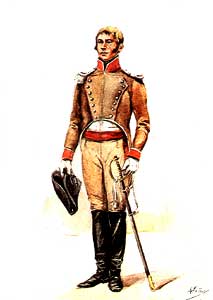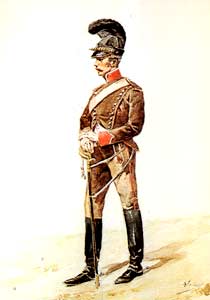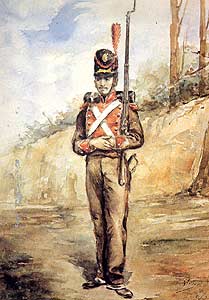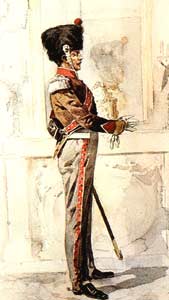'Can you gather a body of five to six thousand men, officers and soldiers of the Portuguese Army, march them in columns of 1,000 men to France and make them swear to serve me?'
Napoleon - November 12th 1807
Napoleon wrote to Marechal Junot again on the Novemeber 20th, he sensed trouble in Portugal and urged Junot to disband the Portugese Army before it could revolt, collecting together those who could be trusted to remain loyal and send them to France.
Junot compiled with these instructions by effectively disbanding the Portugese Army and forming new units from it's remnants, only 6 Infantry regiments and 3 Cavalry regiments were envisaged, more than 75% of the army would be dismissed. On the 16th January 1808 three numbered line regiments and two cavalry regiments were formed from part of the disbanded Portuguese Army. On 20th February a 3rd Cavalry and 4th and 5th Infantry regiments and a battalion of light infantry were ordered formed, the light unit from the remnants of the Legion of Light Troops. All units were to be modeled on the standard French pattern.
The Marquis d’Alorna was appointed as the commander of the force and given the rank of General, however Junot forced him to delegate the raising of this body to Junot's hand picked men, they had secret lists of officers who were considered not to be loyal and would therefore not be allowed to join the new regiments, also men with more than eight years service were ineligible, as were married men and those who had retired, recruits with less than one years service were preferred. In this way it was hoped the Portugese Army could be 'cleansed' of unreliable elements.
The process of raising these units, which began in February 1808 was not complete when on 21 March 1808 Napoleon ordered all Portuguese troops 'formed or not', about 8,000 men in all, to march out of Portugal through Spain to Bayonne and Languedoc in southern France. The soldiers marched in a deplorable state of arrangement, uniforms of all shapes and all colors, more like a band of guerrillas than soldiers, over a third deserted before arriving in France.
On June 1st Napoleon reviewed the Portuguese regiments for the first time. He noted the defects with ordinance, uniform and equipment of our soldiers. However he treated the officers with kindness and offered them a dinner and ordered that the men share a meal with the Imperial Guard. The magnificence of the imperial court strongly impressed the Portuguese, and the soldiers, who had feared being mistreated, were overjoyed.
Napoleon was to write to Bessières that if he had confidence in the Portugese he might as well use them, noting the Sergeants were quite good. Some elements remained with the French army in Spain, notably the light infantry battalion at the first siege of Zaragoza, but it was thought wiser to reorganise the Portuguese Army in France, further from home. On 18th May they were formerly named as a legion within the Grande Armée, to be formed in southern France.
The Portuguese Legion was to have six light infantry regiments of six companies of 140 men each; and two regiments of mounted chasseurs having four squadrons, each with two companies of 100 men. All elements were gathered at Grenoble and Gray during that summer, but only five infantry regiments could be formed by August.
In March 1809 a temporary '13th Elite Provisional Half-Brigade' was formed from the Legion's grenadier and voltigeur companies with the intent to join the campaign against Austria. It was remarked "the twelve companies are superb, all strong men, already well trained and ready to go on campaign". From the moment they crossed the Rhine they were in action and by the time they reached Vienna they had lost 140 men but earned the respect of Marshal Oudinot. They fought with distinction at Wagram (5-6 July) losing over 300 men, causing Napoleon to write "I am pleased with you, part of the victory of Wagram is due you.", he was to award the Legion of Honour to several men.
By the time the rest of the Legion reached Austria the campaign was over, and it returned to its depot at Grenoble.
On 2 May 1811 the establishment was again reduced, for lack of recruits. For some time the French had tried to use Spanish as replacements in the Portugese Legion but it was noted that it was a bad idea to mix Spanish and Portugese, so some 1700 Spaniard's were transferred to the Joesph Napoleon Regiment, and the Porugese Legion was reduced to three infantry regiments and one regiment of mounted chasseurs. In June 1812 the whole Legion marched into Russia, its regiments dispersed between various corps. They again fought with distinction at Krasnoe (14 August), Smolensk (17 August), Polotsk (18 August) and Borodino (7 September) gaining notable praise from both Napoleon and Ney; The cavalry fought of the Cossacks at the Beresina but most of the Legion was lost in the disastrous winter retreat, and Marquis de Alorna himself died on 2nd January 1813.
In April 1813 there remained 965 officers and men including 131 cavalrymen. The cavalry was officially to be disbanded after the armistice and all survivors mustered into a temporary depot battalion though it seems this didn't happen in practice and the cavalry was still in action in 1814 at Chateau Thierry. In October 1813 the troops were ordered to be disarmed along with other 'foreign' units in French service like the JNR and on 25 November the Portuguese Legion was formally disbanded. The men were not released from service but were to be formed into a pioneer battalion though it too was soon disbanded and with it the story of the Portugese Legion ends.
Though they had served, fought and died with honor their future was to be a difficult one, they were unwelcome in the homeland they all longed to see, some settled in France, a few returned to Portugal though the assassin's knife, the hangman's noose or a prison cell awaited some, a sad end for these brave men.
The Marquis d’Alorna was appointed as the commander of the force and given the rank of General, however Junot forced him to delegate the raising of this body to Junot's hand picked men, they had secret lists of officers who were considered not to be loyal and would therefore not be allowed to join the new regiments, also men with more than eight years service were ineligible, as were married men and those who had retired, recruits with less than one years service were preferred. In this way it was hoped the Portugese Army could be 'cleansed' of unreliable elements.
The process of raising these units, which began in February 1808 was not complete when on 21 March 1808 Napoleon ordered all Portuguese troops 'formed or not', about 8,000 men in all, to march out of Portugal through Spain to Bayonne and Languedoc in southern France. The soldiers marched in a deplorable state of arrangement, uniforms of all shapes and all colors, more like a band of guerrillas than soldiers, over a third deserted before arriving in France.
On June 1st Napoleon reviewed the Portuguese regiments for the first time. He noted the defects with ordinance, uniform and equipment of our soldiers. However he treated the officers with kindness and offered them a dinner and ordered that the men share a meal with the Imperial Guard. The magnificence of the imperial court strongly impressed the Portuguese, and the soldiers, who had feared being mistreated, were overjoyed.
Napoleon was to write to Bessières that if he had confidence in the Portugese he might as well use them, noting the Sergeants were quite good. Some elements remained with the French army in Spain, notably the light infantry battalion at the first siege of Zaragoza, but it was thought wiser to reorganise the Portuguese Army in France, further from home. On 18th May they were formerly named as a legion within the Grande Armée, to be formed in southern France.
The Portuguese Legion was to have six light infantry regiments of six companies of 140 men each; and two regiments of mounted chasseurs having four squadrons, each with two companies of 100 men. All elements were gathered at Grenoble and Gray during that summer, but only five infantry regiments could be formed by August.
In March 1809 a temporary '13th Elite Provisional Half-Brigade' was formed from the Legion's grenadier and voltigeur companies with the intent to join the campaign against Austria. It was remarked "the twelve companies are superb, all strong men, already well trained and ready to go on campaign". From the moment they crossed the Rhine they were in action and by the time they reached Vienna they had lost 140 men but earned the respect of Marshal Oudinot. They fought with distinction at Wagram (5-6 July) losing over 300 men, causing Napoleon to write "I am pleased with you, part of the victory of Wagram is due you.", he was to award the Legion of Honour to several men.
By the time the rest of the Legion reached Austria the campaign was over, and it returned to its depot at Grenoble.
On 2 May 1811 the establishment was again reduced, for lack of recruits. For some time the French had tried to use Spanish as replacements in the Portugese Legion but it was noted that it was a bad idea to mix Spanish and Portugese, so some 1700 Spaniard's were transferred to the Joesph Napoleon Regiment, and the Porugese Legion was reduced to three infantry regiments and one regiment of mounted chasseurs. In June 1812 the whole Legion marched into Russia, its regiments dispersed between various corps. They again fought with distinction at Krasnoe (14 August), Smolensk (17 August), Polotsk (18 August) and Borodino (7 September) gaining notable praise from both Napoleon and Ney; The cavalry fought of the Cossacks at the Beresina but most of the Legion was lost in the disastrous winter retreat, and Marquis de Alorna himself died on 2nd January 1813.
In April 1813 there remained 965 officers and men including 131 cavalrymen. The cavalry was officially to be disbanded after the armistice and all survivors mustered into a temporary depot battalion though it seems this didn't happen in practice and the cavalry was still in action in 1814 at Chateau Thierry. In October 1813 the troops were ordered to be disarmed along with other 'foreign' units in French service like the JNR and on 25 November the Portuguese Legion was formally disbanded. The men were not released from service but were to be formed into a pioneer battalion though it too was soon disbanded and with it the story of the Portugese Legion ends.
Though they had served, fought and died with honor their future was to be a difficult one, they were unwelcome in the homeland they all longed to see, some settled in France, a few returned to Portugal though the assassin's knife, the hangman's noose or a prison cell awaited some, a sad end for these brave men.
Infantry
Chasseurs
- Short tailed coat of brown cloth. Red collar piped white. Brown shoulder straps piped red. Red lapels piped white. Red pointed cuffs piped white. Red turnbacks piped white. White metal buttons stamped with "Légion portugaise" around regiment number.
- White waistcoat. Brown breeches. Black short gaiters.
In campaign dress, white cloth overalls with red double side bands and piping. - Black Portuguese type shako (barretina) bearing brass horn over regimental number plate. Black leather peak and brass chin scales.
- White leatherwork. Black leather cartridge pouch and French infantry sabre.
Grenadiers
Scarlet fringed epaulets. Red cords, flounders and plume.
Scarlet fringed epaulets. Red cords, flounders and plume.
Voltigeurs
Green fringed epaulets with scarlet moon. Green cords and flounders and red plume with yellow top.
Green fringed epaulets with scarlet moon. Green cords and flounders and red plume with yellow top.
NCOs
Troopers’ dress with rank laces on both sleeves.
Troopers’ dress with rank laces on both sleeves.
Officers
Troopers’ dress with silver rank epaulets. Scarlet silk sash.
Troopers’ dress with silver rank epaulets. Scarlet silk sash.
Drummers
Troopers’ dress with white lace on collar and lapels and in chevron on both sleeves.
Troopers’ dress with white lace on collar and lapels and in chevron on both sleeves.
Cavalry
Chasseurs
- Short tailed coat of brown cloth. Poppy red collar piped white. Red wings. Red half-lapels piped white. Red pointed cuffs piped white. Red turnbacks piped white and vertical pockets simulated bya red piping. White metal buttons.
In 1812 short tailed single breasted coat of brown cloth with poppy red piping. Poppy red collar, cuffs and turnbacks. - In 1812, brown breeches with red side bands.
cuir noir à chenille de crins noirs. Plumet écarlate. Visière de cuir noir cerclée de laiton et jugulaire en écailles de laiton. - Portuguese type helmet with black leather crown, brass strengthening and black leather comb with black caterpillar. Scarlet plume. Black leather peak with brass strengthening and brass chinscales.
In 1812, black felt shako bearing a brass eagle over shield plate. Company coloured pompon. - White leatherwork. Black leather cartridge pouch. Light cavalry belt with brass buckle and light cavalry sabre with single bar brass hilt and iron scabbard. White sabre strap.
- Black leather light cavalry harness. White sheepskin shabraque with red wolf’s teeth trimming. Cylindrical portmanteau in brown cloth with poppy red lace.
Elite company
In 1812 dress, black fur busby.
In 1812 dress, black fur busby.
Officers
Troopers’ dress with silver thread rank epaulets.
Troopers’ dress with silver thread rank epaulets.
Trumpeters
Troopers’ dress in reversed colours, poppy red coat with brown facings. Yellow within white lace on collar, lapels and cuffs. White wings with yellow inner band. White plume. Brass trumpet with white cord
.jpg)

Links:
LEGIÃO PORTUGUESA AO SERVIÇO DE NAPOLEÃO
La Légion Portugaise
Osprey Men-At-Arms #346 p42
Boppe, P. La Legion Portugaise 1807-1813 ; Paris 1899
Fieffe, E. Histoire des Troupes Etranger au service de France Paris; 1854. 2 Vols
Troopers’ dress in reversed colours, poppy red coat with brown facings. Yellow within white lace on collar, lapels and cuffs. White wings with yellow inner band. White plume. Brass trumpet with white cord
 |  |  |
.jpg)

Links:
LEGIÃO PORTUGUESA AO SERVIÇO DE NAPOLEÃO
La Légion Portugaise
Osprey Men-At-Arms #346 p42
Boppe, P. La Legion Portugaise 1807-1813 ; Paris 1899
Fieffe, E. Histoire des Troupes Etranger au service de France Paris; 1854. 2 Vols




No comments:
Post a Comment